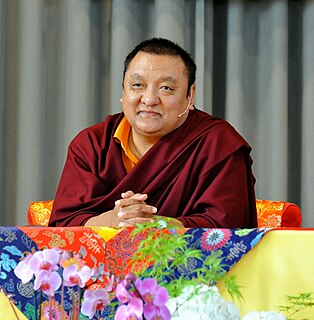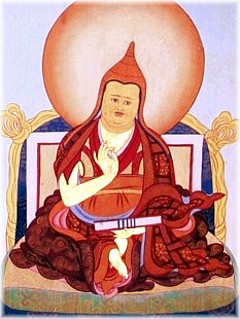Mipham Wangpo (Tibetan : མི་ཕམ་དབང་པོ, Wylie : mi pham dbang po, 1641–1717) was considered to be the immediate re-incarnation of Gyalwang Pagsam Wangpo and the sixth Gyalwang Drukchen hierarch of the Northern branch of the Drukpa Kagyu tradition of Tibetan Buddhism.

The Tibetan script is an abugida of Indic origin used to write the Tibetic languages such as Tibetan, as well as Dzongkha, Sikkimese, Ladakhi and sometimes Balti. The printed form is called uchen script while the hand-written cursive form used in everyday writing is called umê script.

The Wylie transliteration system is a method for transliterating Tibetan script using only the letters available on a typical English language typewriter. It bears the name of American tibetologist Turrell V. Wylie, who described the scheme in an article, A Standard System of Tibetan Transcription, published in 1959. It has subsequently become a standard transliteration scheme in Tibetan studies, especially in the United States.
Pagsam Wangpo, a key figure in the history of the Drukpa Lineage of Tibetan Buddhism, was born at Chonggye, in the Tsang province of Tibet a natural son of the prince of Chonggye, Ngawang Sonam Dragpa. He was an elder cousin of the 5th Dalai Lama, Ngawang Lobzang Gyatso (1617-1682).
Contents
He was born at Phoding in Lhodrak, Kharchu district of southern Tibet and recognized by the 5th Dalai Lama as the Omniscient Drukchen incarnation. He spent most of his formative years at Lhasa in the Potala Palace of the Dalai Lama and studying at the monastic colleges of Sera, Drepung, and Gaden.

Ngawang Lobsang Gyatso was the 5th Dalai Lama and the first Dalai Lama to wield effective temporal and spiritual power over all Tibet. He is often referred to simply as the Great Fifth, being a key religious and temporal leader of Tibetan Buddhism and Tibet. Gyatso is credited with unifying all Tibet after a Mongol military intervention which ended a protracted era of civil wars. As an independent head of state, he established diplomatic relations with China and other regional countries and also met early European explorers. Gyatso also wrote 24 volumes' worth of scholarly and religious works on a wide range of subjects.

The Potala Palace is a dzong fortress in the city of Lhasa, in China's Tibet Autonomous Region. It was the winter palace of the Dalai Lamas from 1649 to 1959, has been a museum since then, and is a World Heritage Site since 1994.

Sera Monastery is one of the "great three" Gelug university monasteries of Tibet, located 1.25 miles (2.01 km) north of Lhasa and about 5 km (3.1 mi) north of the Jokhang. The other two are Ganden Monastery and Drepung Monastery. The origin of its name is attributed to a fact that during construction, the hill behind the monastery was covered with blooming wild roses.
Mipham Wangpo was an influential figure in settling the Ladakh-Tibet war of 1679–1684.










